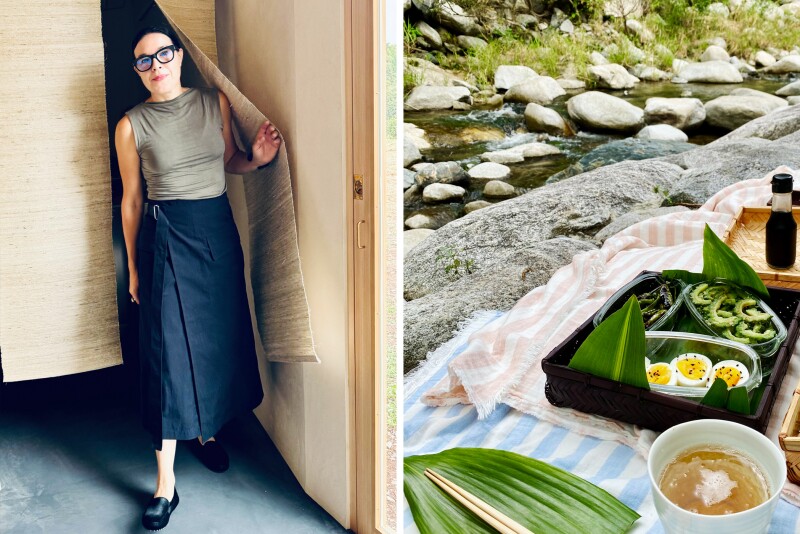In a kitchen in rural southern Japan, Prairie Stuart-Wolff measures rice with a small wooden box called a masu. She pours the petite, translucent kernels into a pot and, as we wait for them to cook, she shows me how to slice bitter melon using a masterfully crafted knife engraved with the letter P and roast shishitos using cooking chopsticks known as saibashi. As we work, I ask questions about the objects that surround us. Like the masu, each is characterized by an equal balance of beauty and function. It seems everything has been whittled, welded, or woven by a friend.
A black kitten plays at our feet while the room fills with the aroma of warm rice. It is an everyday smell, as well as the smell of a season—one I know intimately, having lived most of my life in proximity to rice fields, first in northern California and later in southern Tuscany. Now in Kyushu, I learn that the rice harvest occurs simultaneously in all three regions, around late September or early October. But time—like rice—is measured differently here. While much of the world divides the calendar into four seasons, Japan observes seventy-two microseasons, called kō, that cover four or five days each.

At Mirukashi Salon, Prairie Stuart-Wolff (pictured left) and Hanako Nakazato help guests appreciate the microseason through specific culinary preparations, often served in Nakazato’s stoneware.
Courtesy of Mirukashi Salon (left); Elena Valeriote (right)
I’m with Wolff because she and her wife, Hanako Nakazato, help travelers experience the many almost imperceptible transformations occurring around us daily through thoughtful food-focused programs. My 24-hour visit is a taste of what they offer, but it is a perfect reflection of the singularity of this day, its in-season ingredients, and ever-changing weather—including a double rainbow.
We meet in mid-September. Elsewhere in the northern hemisphere, summer is fading into autumn, but here it is Sekirei naku or “wagtails sing”—one of many microseasons named for birds—which occurs shortly after Kokumono sunawachi minoru, or “rice ripens.” Each of the seventy-two microseasons has a unique name linked to wildlife, weather, or agriculture, and many are associated with specific ingredients, poems, or philosophical concepts.
Japan is known globally for how its residents appreciate and celebrate the seasons, particularly when cherry trees are in bloom. The Japanese language even has a term, kigo, that describes words with a sense of seasonality.
Having grown up in New England, Wolff learned about Japan’s microseasons only after moving here in 2007 with her wife. A 14th-generation potter, Nakazato had been apprenticing in Vermont when she met Wolff and later wanted to move back to Japan to open her own pottery studio. The two settled in the countryside outside Karatsu, about an hour south of Fukuoka along the west coast.
“Even if we weren’t a couple, I think we would stand out here for different reasons—for being women, having our own businesses, living independently,” says Wolff, who notes that they are still treated with “a sense of respect.” She adds, “I feel we are seen as a couple and as two women building a life together, but that has come through an investment of time.”

Mirukashi Salon hosts events in a purpose-built space with a copper kitchen and many handmade elements.
Courtesy of Mirukashi Salon
Nakazato joins us in the kitchen after finishing her morning work in the studio. She explains, “When we moved here, Prairie spent a lot of time with my mother, who was an excellent cook. Prairie didn’t speak Japanese, and my mom didn’t speak English, so Prairie would stand next to her in the kitchen, learning the language and food.”
“I started to correlate the seasons with how we were eating, what we were foraging, what I was seeing in the landscape,” adds Wolff, whose background was in writing and photography, though she always had an interest in food. “Living in the countryside, I came to sense and understand those subtle shifts.”
For years, she wrote about this experience on a blog, which led her to launch an in-person salon in 2023. Through Mirukashi Salon, Wolff hosts seven sessions throughout the year, inviting small groups of up to seven guests to participate in four-day itineraries of cooking classes and other immersive culinary activities. These activities, often held in collaboration with local artisans, range from foraging edible ferns and making soba noodles to visiting a soy brewery and attending a tea ceremony.

Guests learn about specific seasons at the salon, including the rice-harvesting process.
Courtesy of Mirukashi Salon
The humid, late summer air is as sticky as the rice when we arrive at a gentle river running between verdant hills, picnic basket in tow. Wolff, Nakazato, and I take a dip before enjoying our temarizushi (a rounded sushi named after children’s toys), roasted shishitos, bitter melon dressed in sesame oil, soft-boiled eggs sprinkled with black sesame seeds, and homemade ume (plum) soda served in a cup made by Nakazato.
Nakazato’s pottery—produced under her studio name, Monohanako—plays a significant role in the Mirukashi Salon sessions. On the first day of the salon, guests ceremoniously select a Monohanako sake cup to drink from and later join Nakazato in her studio to watch her work. Visitors also enjoy a meal served on Monohanako pottery at Tamatori, a restaurant in the nearby town of Karatsu.
When I visit, Wolff is still hosting salon sessions in the home she and Nakazato share, but as of October 2024, guests will gather in a soothing, purpose-built space nestled among tea plants.
“The space exhibits the intention I have for the salon and for everyday living. Every object, every ingredient, every action has meaning and purpose,” says Wolff. “Everything is in connection to this landscape and community.”











